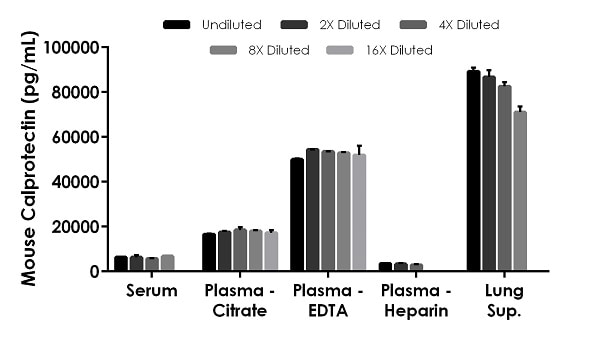Mouse Calprotectin ELISA Kit (S100A8/S100A9) (ab263885)
Key features and details
- One-wash 90 minute protocol
- Sensitivity: 270.3 pg/ml
- Range: 468.75 pg/ml - 30000 pg/ml
- Sample type: Cell culture supernatant, Cit plasma, EDTA Plasma, Hep Plasma, Serum
- Detection method: Colorimetric
- Assay type: Sandwich (quantitative)
- Reacts with: Mouse
Overview
-
Product name
Mouse Calprotectin ELISA Kit (S100A8/S100A9)
See all MRP8 kits -
Detection method
Colorimetric -
Precision
Intra-assay Sample n Mean SD CV% Plasma 8 3.2% Inter-assay Sample n Mean SD CV% Plasma 3 0.6% -
Sample type
Cell culture supernatant, Serum, Hep Plasma, EDTA Plasma, Cit plasma -
Assay type
Sandwich (quantitative) -
Sensitivity
270.3 pg/ml -
Range
468.75 pg/ml - 30000 pg/ml -
Recovery
Sample specific recovery Sample type Average % Range Cell culture supernatant 106 102% - 109% Serum 82 80% - 84% Hep Plasma 87 81% - 91% EDTA Plasma 92 80% - 101% Cit plasma 88 82% - 95% -
Assay time
1h 30m -
Assay duration
One step assay -
Species reactivity
Reacts with: Mouse
Does not react with: Cow -
Product overview
Mouse Calprotectin ELISA Kit (S100A8/S100A9) (ab263885) is a single-wash 90 min sandwich ELISA designed for the quantitative measurement of Calprotectin (S100A8/S100A9) protein in cell culture supernatant, cit plasma, edta plasma, hep plasma, and serum. It uses our proprietary SimpleStep ELISA® technology. Quantitate Mouse Calprotectin (S100A8/S100A9) with 270.3 pg/ml sensitivity.
SimpleStep ELISA® technology employs capture antibodies conjugated to an affinity tag that is recognized by the monoclonal antibody used to coat our SimpleStep ELISA® plates. This approach to sandwich ELISA allows the formation of the antibody-analyte sandwich complex in a single step, significantly reducing assay time. See the SimpleStep ELISA® protocol summary in the image section for further details. Our SimpleStep ELISA® technology provides several benefits:
- Single-wash protocol reduces assay time to 90 minutes or less
- High sensitivity, specificity and reproducibility from superior antibodies
- Fully validated in biological samples
- 96-wells plate breakable into 12 x 8 wells stripsA 384-well SimpleStep ELISA® microplate (ab203359) is available to use as an alternative to the 96-well microplate provided with SimpleStep ELISA® kits.
-
Notes
Calprotectin (S100A8/S100A9) is a heterodimer of the proteins S100A8 and S100A9. Calprotectin carries a wide variety of intra- and extracellular functions such as being involved in cytoskeletal structure, signal transduction, inflammation, antimicrobial activity, and apoptosis-inducing activities. Studies have shown calprotectin to have a prominent role in various pathophysiological processes in which targeting calprotectin may help prevent or minimize the severe effects of inflammation and associated diseases.
-
Platform
Pre-coated microplate (12 x 8 well strips)
Properties
-
Storage instructions
Store at +4°C. Please refer to protocols. -
Components 1 x 96 tests 10X Mouse Calprotectin (S100A8/S100A9) Capture Antibody 1 x 600µl 10X Mouse Calprotectin (S100A8/S100A9) Detector Antibody 1 x 600µl 10X Wash Buffer PT (ab206977) 1 x 20ml Antibody Diluent CPR 1 x 6ml Mouse Calprotectin (S100A8/S100A9) Lyophilized Recombinant Protein 2 vials Plate Seals 1 unit Sample Diluent NS (ab193972) 1 x 50ml SimpleStep Pre-Coated 96-Well Microplate (ab206978) 1 unit Stop Solution 1 x 12ml TMB Development Solution 1 x 12ml -
Research areas
-
Function
Calcium-binding protein. Has antimicrobial activity towards bacteria and fungi. Important for resistance to invasion by pathogenic bacteria. Up-regulates transcription of genes that are under the control of NF-kappa-B. Plays a role in the development of endotoxic shock in response to bacterial lipopolysaccharide (LPS) (By similarity). Promotes tubulin polymerization. Promotes phagocyte migration and infiltration of granulocytes at sites of wounding. Plays a role as pro-inflammatory mediator in acute and chronic inflammation and up-regulates the release of IL8 and cell-surface expression of ICAM1. Extracellular calprotectin binds to target cells and promotes apoptosis. Antimicrobial and proapoptotic activity is inhibited by zinc ions. -
Tissue specificity
Expressed by macrophages in chronic inflammations. Also expressed in epithelial cells constitutively or induced during dermatoses. -
Sequence similarities
Belongs to the S-100 family.
Contains 2 EF-hand domains. -
Cellular localization
Secreted. Cytoplasm. Cytoplasm > cytoskeleton. Cell membrane. Associates with tubulin filaments in activated monocytes. Targeted to the cell surface upon calcium influx. Released from blood leukocytes upon exposure to CSF2/GM-CSF, bacterial lipopolysaccharide (LPS) and during inflammatory processes. Serum levels are high in patients suffering from chronic inflammation. - Information by UniProt
-
Alternative names
- 60B8Ag
- AI323541
- B8Ag
see all -
Database links
- Entrez Gene: 20201 Mouse
- SwissProt: P27005 Mouse
- Unigene: 21567 Mouse
Images
-
SimpleStep ELISA technology allows the formation of the antibody-antigen complex in one single step, reducing assay time to 90 minutes. Add samples or standards and antibody mix to wells all at once, incubate, wash, and add your final substrate. See protocol for a detailed step-by-step guide.
-
The Calprotectin standard curve was prepared as described in Section 10. Raw data values are shown in the table. Background-subtracted data values (mean +/- SD) are graphed.
-
 Interpolated concentrations of native Calprotectin in mouse serum, plasma and tissue culture supernatant samples.
Interpolated concentrations of native Calprotectin in mouse serum, plasma and tissue culture supernatant samples.The concentrations of Calprotectin were measured in duplicates, interpolated from the Calprotectin standard curves and corrected for sample dilution. Undiluted samples are as follows: serum 50%, plasma (citrate) 50%, plasma (EDTA) 50%, plasma (heparin) 50% and lung supernatant 1:20. The interpolated dilution factor corrected values are plotted (mean +/- SD, n=2). The mean Calprotectin concentration was determined to be 6,236 pg/mL in serum, 17,549 pg/mL in plasma (citrate), 52,502 pg/mL in plasma (EDTA), 3,225 pg/mL in plasma (Heparin), and 81,971 pg/mL in lung supernatant.
-
To learn more about the advantages of recombinant antibodies see here.












